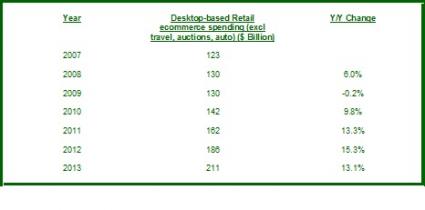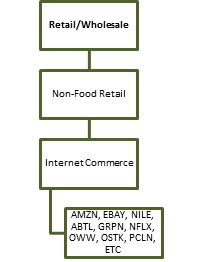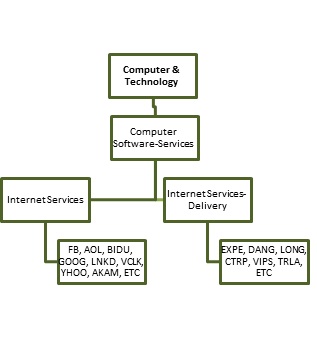The Electronic Commerce, or e-commerce industry is one of the most progressive sectors of the economy. The industry is evolving very rapidly, so data collection and evaluation are particularly difficult. Consequently, one has to rely largely on surveys by both government and private agencies.
According to the U.S. Census Bureau, the manufacturing sector is relatively more reliant on e-commerce (51.9% of their total shipments), followed by merchant wholesalers (26.4% of their total sales). These two segments make up the business-to-business category.
Retailers and service providers generated just 5.2% and 3.1%, respectively of their revenues online, with retailers growing faster than service providers. The Bureau categorizes these two segments as business-to-consumer.
All except the services segment grew around 5% over the prior year. Services grew 4%. [All the above data from the U.S. Census Bureau relate to 2012, as published in May 2014].
The U.S. Commerce Department estimates that ecommerce sales in the country grew 16.9% in 2013 to reach $263.3 billion.
Retail
Total retail e-commerce grew 2.8% sequentially and 15.0% year over year to 6.2% of total retail sales in the first quarter of 2014, according to the quarterly retail trade survey by the Census Bureau. Forrester Research estimates that this share will go up to 11% by 2018.
comScore data (as compiled in the table below) indicates that this segment recovered very quickly from the economic downturn and continued to grow rapidly over the last few years.
Key Drivers
Since the industry is in evolution, the drivers are changing. For instance, the initial push came from the time savings and convenience of online transactions. To this were added the benefits of comparison shopping and personal recommendations. As technology required for personalized recommendations developed, became more available and its benefits more evident, most e-tailers started adding the feature until it is now considered a must-have.
The adoption of smartphones, tablets and other mobile Internet devices remains the biggest driver of retail ecommerce sales. In fact, trends indicate that consumers prefer mobile browsers when shopping, searching and entertaining themselves, while preferring apps for navigation and acquiring information.
Ecommerce sales through mobile actually dropped off slightly to around 10.5% in 2013 from 11% in 2012 (as deduced from recent findings by comScore). Earlier, comScore predicted that this share would go up to 26% in 2017. Mobile commerce is likely to benefit from the fact that screen sizes of mobile devices are getting larger (phablets and larger tablets).
eMarketer estimates that tablets generated 65% of m-commerce sales in 2013, with smartphones accounting for the rest.
While both tablets and smartphones are extremely convenient when on the move, tablets have several additional advantages. In fact, they are a boon to the ecommerce industry, since the larger screens offer better visibility of online stores and merchandise, thus facilitating purchases.
Average spending per user on tablets is therefore 20% higher than on smartphones but since more people have smartphones, their overall share of ecommerce spending is lower. Given the unique advantages of smartphones and tablets, it appears that they are working in conjunction to boost total online retail sales. Additionally, the inherent cost savings and convenience of “showrooming” ensures that the trend will continue.
Continued advancements in technology are improving navigation and customer experience on ecommerce sites, which is improving reviews and thus drawing more traffic to the sites.
The digital consumption of books, music, video and games all over the world is extending the reach of these goods and thereby boosting sales. Therefore, previously unconnected electronic goods, such as TVs and game consoles are now being modified to enable connectivity. On the other side of the fence, online versions of books, music, video and games that can be downloaded and consumed on a traditional computer or any other connected device are becoming available.
Since the shift in consumption patterns is resulting in multi-functional electronic gadgets that are no longer optimized for a particular activity, there is a great drive to develop technologies that could improve the quality of each experience.
Free shipping remains a major lure. However, shipping/logistics is a cost that ecommerce companies are required to absorb. So they are doing everything they can to take down costs. Some, like Amazon (NASDAQ:AMZN), are supplementing the “local” feature (customer pickup from nearby store at his/her own convenience) with a larger number of more strategically located fulfillment centers.
Amazon is systematically doing away with traditional package delivery companies like UPS (NYSE:UPS)) and Fedex (NYSE:FDX) because it operates on very thin margins. Online marketplaces like Alibaba are teaming up with local delivery companies (in China) to create a massive distribution network.
Top-Selling Items
With retail of all kinds gradually moving online, picking specific categories to focus on has become a challenge. Individual product categories can broadly be classified today as books/music/video, apparel and accessories, auto and parts, consumer/CE, toys/hobby, home furniture/furnishings, health, food/beverage, office equipment and supplies, and other.
A recently published ecommerce study indicates that all these categories will grow at a mid-teens percentage rate this year with the exception of books/music/video which will be somewhat stronger. But growth rates are expected to moderate across categories to the low double-digits by 2018.
Apparel is a huge market and although online sales are currently under 10% of total apparel sales, the category already generates the most dollars. Selling tools, such as zoom, color swatching and configurators are helping the process. Even primarily brick-and-mortar outfits like Macy’s (NYSE:M) sees that consumers purchasing through multiple channels (online and offline stores) tend to spend more. This is encouraging traditional retailers to offer an online store to supplement their physical stores. Online sales also show better conversions since searches usually draw consumers with a prior intention to purchase.
The increase in technology purchases over the Internet is driven by not only individual consumers, but also companies and governments. The efficient and timely processing of orders, choice of payment options, subscription-selling and sales under the SaaS model are all facilitators.
The Association of American Publishers (AAP) says that ebook sales in the U.S. flattened out in 2013 due to difficult comps, particularly in the children’s category. Publishers also took pricing actions, which affected revenues. Units however, grew 10.1% according to BookStats, a joint project between the AAP and the Book Industry Study Group. With a penetration rate in the mid-teens percentage range, the scope for market expansion is present.
However, the shift in preference from e-readers to tablets that offer other forms of entertainment, such as movies, games, songs and so on, is a deterrent (a Bowker Market Research survey and wsj.com). U.S. players continue to see strength in international markets. Amazon and Apple (NASDAQ:AAPL) are the primary channels facilitating international expansion, although other smaller players and local companies in international markets are also playing a part.
Google (NASDAQ:GOOGL) sites remained the forerunner facilitating online video consumption, with significantly higher unique viewers (UVs) than any of the others. Facebook (NASDAQ:FB), which has moved up the ranks pretty fast (helped by 6-second Vine videos and auto-load videos), retained the second position. AOL Media Network, Yahoo (NASDAQ:YHOO) sites, NDN sites and VEVO sites (in which Google’s YouTube recently acquired a stake) took the next few positions.
Notably, Microsoft (NASDAQ:MSFT) broke into the top ten for the first time snagging the ninth position while Amazon dropped several positions to number 10. The difference between positions 5 to 10 is small. [comScore estimates, Apr 2014]
The Cisco (NASDAQ:CSCO) VNI initiative has forecast global consumer Internet video traffic to increase from 66% of total consumer Internet traffic in 2013 to 79% in 2018, with Internet TV increasing 3 percentage points by then and VoD doubling. This represents tremendous opportunity in terms of video content sales and ad revenues.
The digital consumption of music has seen huge growth since Apple announced its first iPod. Amazon and others are also seeing their business grow. In 2013 however, digital track sales declined around 6% while digital album sales stayed flat (Nielsen). The decline is attributable to streaming services, such as YouTube and Spotify, which saw volumes increase 32%.
A recent IFPI report shows that digital music could finally bring a turnaround in the music business, which has been in the doldrums for many years. While piracy remains a major concern, licensed and ad supported music streaming services are growing in popularity.
The gaming segment has suffered over the last few quarters, impacted by the economic slowdown that affected consumer spending. However, while this affected total gaming spend, it did not affect the online segment, which gained from the increasing digitization of games, the desire to play across multiple platforms and the availability of free-to-play games to draw customers. As a result, sales through online channels continue to grow at the expense of traditional retail. The release of the new Play Station 4 from Sony and Xbox One from Microsoft are also helping sales right now.
Mobile will have an impact on the hottest-selling categories. A recent compilation of mobile app downloads indicates that games were by far the most popular, accounting for 23% of app downloads across devices. Entertainment, utilities and education followed with 11%, 10% and 7% shares, respectively. Relatively less downloaded were categories like books, lifestyle, healthcare, travel, music, navigation, finance and social networking.
But since video, games and music are often social activities, they are increasingly being marketed on social platforms such as Facebook and Pinterest.
Facebook’s SocialStore, as it is called uses MarketLive's Intelligent Commerce Platform that enables marketers to display product information, promotions/discounts, shopping carts and check-out options. Both comparative shopping and comparative pricing are possible. The basic advantages of the system that are currently being touted are that it allows easy brand building, creates meaningful commercial relationships and makes use of account-holders’ social connections to attract new buyers.
An E-tailing Group study reveals that of 100 U.S. consumer product merchants with e-commerce websites surveyed, 98 had a Facebook account. Around 90% of these redirected the user to the merchant’s own page, 96% had loaded brand-building videos, 56% had product-oriented videos, 44% had store locators and 38% had promotions.
Facebook remains the leader by far in the social networking space, with monthly average users that are significantly higher than other networks such as Tumblr, Pinterest, Twitter (NYSE:TWTR)), LinkedIn (NYSE:LNKD) and others. Its recent acquisition of WhatsApp ensures that user growth will remain very strong, despite the strength at peers. Engagement on Facebook also compares favorably with its peers.
Selling discount coupons is also helping retail. Groupon (NASDAQ:GRPN) is the leader here, which along with its closest rival LivingSocial offers discount coupons with a very low shelf life from local players looking for sales. The company offers huge discounts to attract buyers and collects a percentage of the sales thus generated. Groupon is also building a deals marketplace, which is likely to further drive sales.
As a result, not just Amazon and Google, but also a host of other much smaller parties have started doing some business in this format. Technology investments are also required in order to serve customer needs effectively. The deals market appears to be improving and there could be some growth this year.
Research Indicates Improving Prospects
A recent report from Forrester indicates that online spending (excluding travel) in the U.S. will increase at a 9.5% CAGR to reach $414 billion by 2018.
Since ecommerce entails the buying and selling of goods or services over electronic systems, it includes companies that are totally dependent on these sales, those that are gradually moving to it, as well as those that want to use it partially. Therefore, the biggest sellers or the ones growing the strongest are not necessarily those that are solely dependent on the Internet. The following diagrams seek to explain the position of companies primarily dependent on the Internet for the distribution of their goods and services in the context of the Zacks Industry Rank.
Two (Retail/Wholesale and Computer & Technology) of the 16 broad Zacks sectors are related to the ecommerce industry as depicted below.


We rank the 264 industries across the 16 Zacks sectors based on the earnings outlook and fundamental strength of the constituent companies in each industry.
The outlook for industries positioned at #88 or lower is 'Positive,' between #89 and #176 is 'Neutral' and #177 and higher is 'Negative.'
Therefore, Internet Services – Delivery and Internet Commerce being in the 176th and 218th positions, respectively are in negative territory, with Internet Services (168th position) being neutral.
So it is not surprising that the average rank of stocks in the Internet Services – Delivery industry is 3.12, for Internet Commerce, it is 3.29, while for Internet Services it is 3.09. [Note: Zacks Rank #1 denotes Strong Buy, #2 is Buy, #3 means Hold, #4 Sell and #5 Strong Sell].
Earnings Trends
The broader Retail/Wholesale sector, of which Internet Commerce is a part, should see improving growth rates.
Total earnings for the sector are expected to increase 3.9% in the second quarter on revenue growth of 7.6%. This contrasts with an earnings growth of 0.4% based on revenue growth of 3.8% in the preceding quarter.
The other companies we are discussing in the e-commerce outlook (Part 2) fall under the broader Technology sector. Here we see a decline in earnings and slight improvement in revenue.
Specifically, earnings growth is expected to drop to 2.3% (from 4.4% in the previous quarter), while revenue growth is expected to be 3.7% (up from 2.7% in the previous quarter).
Market Position
According to a recently-released report from Internet Retailer, Amazon remained miles ahead of the competition in the retail ecommerce market. Amazon’s sales in 2013 were more than the next nine companies combined. Apple was in second spot, as Internet Retailer started including its online hardware sales for the first time.
Apple was followed by traditional retailers Staples (NASDAQ:SPLS), Wal-Mart Stores (NYSE:WMT)) and Sears (NASDAQ:SHLD), followed by Liberty Interactive (NASDAQ:LINTA), Netflix (NASDAQ:NFLX), Macy’s, Office Depot (NYSE:ODP)) and Dell. Traditional retailers are benefiting from local pickups (since they already have many stores and online retailers are having fulfillment issues. Tying up with marketplaces like eBay (NASDAQ:EBAY) is also helping.
OPPORTUNITIES
Opportunities are hard to come by considering the way the sector is doing now. There are huge growth prospects, so companies are mostly in the investment mode. Naturally, at this stage there are execution risks, or at least some uncertainty regarding the time by which investments will bear fruit. In this scenario, we see some opportunity in Office Depot and Petmed Express (NASDAQ:PETS).
WEAKNESSES
Nearly all the Internet retailers have issues at present. That’s because Internet retailing requires proper fulfillment and a solid technology platform to be successful and both these factors become difficult as the companies grow. Moreover, the pursuit of growth in international markets is an absolute necessity, because stealing business from traditional retailers can only take them so far. Besides, traditional are increasingly using their own e-tailing platforms, which have seen solid growth.
Generally, there is execution uncertainty related to the investments significant investments that online retail companies have been making. Some of these that we would like to caution against include Amazon.com, eBay, Blue Nile (NASDAQ:NILE) and Autobytel (NASDAQ:ABTL).
